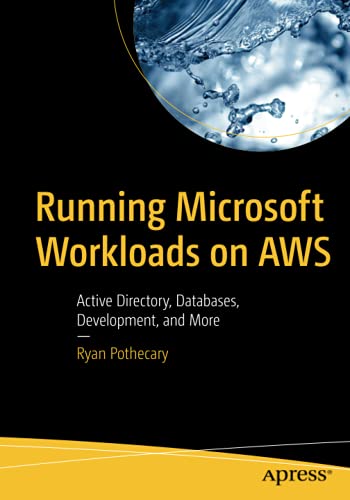Download Running Microsoft Workloads on AWS: Active Directory, Databases, Development, and More PDF Free - Full Version
Download Running Microsoft Workloads on AWS: Active Directory, Databases, Development, and More by Ryan Pothecary in PDF format completely FREE. No registration required, no payment needed. Get instant access to this valuable resource on PDFdrive.to!
About Running Microsoft Workloads on AWS: Active Directory, Databases, Development, and More
Did you know that Amazon Web Services runs nearly double the amount of Microsoft Workloads in the cloud than any other provider?<br><br>Running Microsoft Workloads in AWS is your single-source solution for learning the best practice skills and guidance that AWS consultants offer their customers in the field. Over 70% of enterprise workloads are based on Microsoft technologies and AWS has been running these technologies in the AWS Cloud for more than 12 years―far longer than Microsoft’s own Azure cloud platform.<br><br>This book introduces AWS foundations and compares them to traditional Microsoft architectures, showing you how to design your AWS Cloud platform to run your current Microsoft solutions. It covers the crucial area of identity and access control, showing how to implement Active Directory inside the AWS platform and the most secure ways of enabling Single Sign On from your own data centers and from Microsoft AzureAD.<br><br>The book goes in-depth and shows how developers across the globe are using their existing .NET skills to develop directly on top of AWS, using current AWS development services such as AWS Code Pipeline, AWS Code Build, and AWS Code Deploy to create the next generation of cloud-native applications using the most popular cloud serverless service―AWS Lambda.<br><br>What You Will Learn<br>• Be familiar with the basic building blocks of AWS and how the terminology differs from your own data center and Microsoft Azure<br>• Understand Amazon Machine Images (AMI) strategies and solutions to best manage the trade-off between speed and manageability<br>• Run one of the most popular Microsoft products: SQL Server on AWS<br>• Be aware of the different database architecture designs for using Amazon RDS and Amazon EC2<br>• Read an overview of Serverless Development in the AWS cloud from a Microsoft .NET perspective<br>• Know migration strategies for moving your Microsoft Workloads to the AWS Cloud<br><br>Who This Book Is For<br>Covers high-level concepts and solutions for CTOs and CCTOs; provides a solution for architects; and dives deep into the topic for administrators and DevOps engineers
Detailed Information
| Author: | Ryan Pothecary |
|---|---|
| Publication Year: | 2021 |
| ISBN: | 1484266277 |
| Pages: | 310 |
| Language: | other |
| File Size: | 11.011 |
| Format: | |
| Price: | FREE |
Safe & Secure Download - No registration required
Why Choose PDFdrive for Your Free Running Microsoft Workloads on AWS: Active Directory, Databases, Development, and More Download?
- 100% Free: No hidden fees or subscriptions required for one book every day.
- No Registration: Immediate access is available without creating accounts for one book every day.
- Safe and Secure: Clean downloads without malware or viruses
- Multiple Formats: PDF, MOBI, Mpub,... optimized for all devices
- Educational Resource: Supporting knowledge sharing and learning
Frequently Asked Questions
Is it really free to download Running Microsoft Workloads on AWS: Active Directory, Databases, Development, and More PDF?
Yes, on https://PDFdrive.to you can download Running Microsoft Workloads on AWS: Active Directory, Databases, Development, and More by Ryan Pothecary completely free. We don't require any payment, subscription, or registration to access this PDF file. For 3 books every day.
How can I read Running Microsoft Workloads on AWS: Active Directory, Databases, Development, and More on my mobile device?
After downloading Running Microsoft Workloads on AWS: Active Directory, Databases, Development, and More PDF, you can open it with any PDF reader app on your phone or tablet. We recommend using Adobe Acrobat Reader, Apple Books, or Google Play Books for the best reading experience.
Is this the full version of Running Microsoft Workloads on AWS: Active Directory, Databases, Development, and More?
Yes, this is the complete PDF version of Running Microsoft Workloads on AWS: Active Directory, Databases, Development, and More by Ryan Pothecary. You will be able to read the entire content as in the printed version without missing any pages.
Is it legal to download Running Microsoft Workloads on AWS: Active Directory, Databases, Development, and More PDF for free?
https://PDFdrive.to provides links to free educational resources available online. We do not store any files on our servers. Please be aware of copyright laws in your country before downloading.
The materials shared are intended for research, educational, and personal use in accordance with fair use principles.

